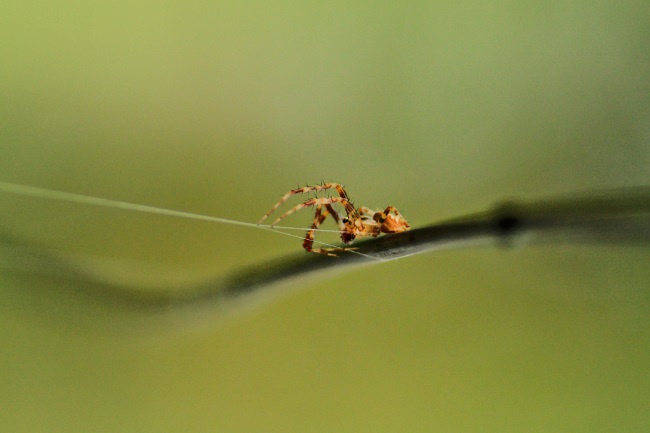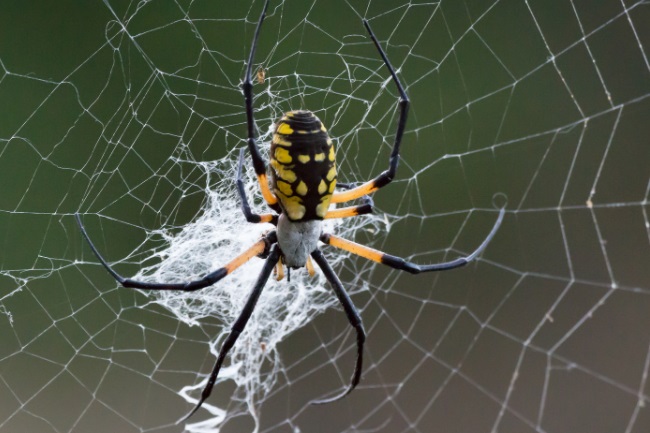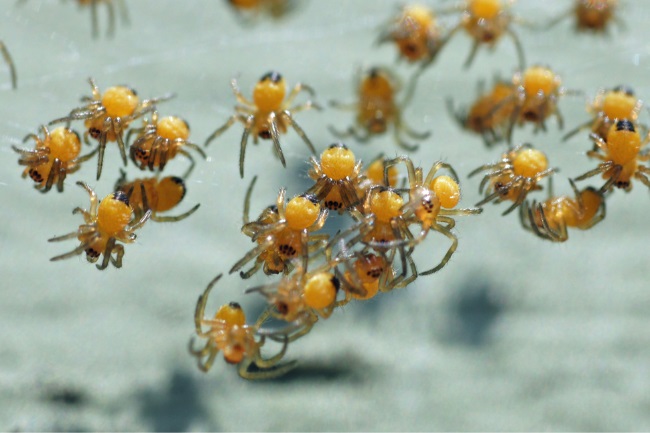Where garden spiders (Araneus diadematus) go in the winter depends slightly on what climate they live in. Those who live in a warmer climate tend to mature more quickly and therefore only live a year, dying after laying their eggs in autumn. Those who live in cooler temperatures develop more slowly and spend winter in diapause, a state similar to hibernation.
Contents
One year or two
We tend to think of all animals within a species as living the same kind of life. However, individuals can often adapt to different conditions. For example, an oak tree that lives out in an open field will grow big and tall, whereas one growing amongst rocks up high on a mountainside can reach the same great age but never grow more than a few feet high. The same is true for garden spiders.

This tiny spider is found across Europe and into North America. It lives in a wide range of habitats, including woodlands, meadows and urban environments. Research has found that when the garden spider lives in warm climates, where plentiful prey is available, they can complete their lifecycle in a year. Whereas when they find themselves in cooler temperatures or places with less available food, they will take two years to mature. It’s even been found that this one to two-year cycle can vary within a country or particular area, with sunny slopes being more likely to support a one year cycle.
| Spider Species | Common Name | Winter Locations |
|---|---|---|
| Araneus diadematus | Cross Orbweaver | Under tree bark, leaf litter, or in crevices |
| Argiope aurantia | Yellow Garden Spider | Silken retreats in vegetation, under bark |
| Neoscona spp. | Spotted Orbweavers | Sheltered areas, under tree bark, leaf litter |
| Misumena vatia | Flower Crab Spider | Under loose tree bark or in plant debris |
| Thomisus spp. | Crab Spiders | Overwinter as adults on plants or in leaf litter |
If the spiders mature in a year, they can mate at the end of their first summer. For both males and females, this is generally the end of the road, the males because the females often eat them after mating, whilst the females use up all their energy in producing young and die soon afterwards. This means that some garden spiders will not spend winter as an adult.
Also read: How Long Does a Garden Spider Live? (Explained)
Life in a sleeping bag
The female spider’s last job is to weave a wonderful silken egg sac for her eggs. This egg sac is essential to stop the eggs from freezing in the cold winter weather. She will also give them a helping hand by ensuring she places the egg sac somewhere safe and secure where it is likely to stay nice and warm, such as under the bark of a rotten tree.

Therefore, all garden spiders spend their first winter as an egg, safe in their silken sleeping bag. It’s not till May that the spiderlings emerge and begin to explore their environment; however, both of their parents will have been long dead by then.
| Survival Strategy | Description |
|---|---|
| Diapause | Enter a dormant state known as diapause, reducing metabolic activity and conserving energy. |
| Seek shelter | Find sheltered locations such as under tree bark, in crevices, or in leaf litter. |
| Produce antifreeze | Some species produce glycerol or other compounds that act as antifreeze, protecting them from freezing temperatures. |
| Decreased activity | Reduce activity levels and stay hidden to conserve energy during the winter months. |
Anti-freeze
Those garden spiders who live two years will have to spend one winter in their adult form. There’s little for garden spiders to eat during winter, and the cold weather can result in their deaths.
They will seclude themselves somewhere warm and sheltered to avoid the frost, such as under a pile of wood or in cracks in the stone. They’ll even venture into our sheds, or garages, for a chance to keep warm.
One adaptation that many spiders have, who wait out the winter, is the accumulation of a chemical similar to anti-freeze in their blood. This allows them to survive the freezing temperatures without ice crystals forming inside them and tearing apart their cells.
Safe and warm
Some spiders go further than the rest to keep themselves warm in the winter. Rather than just sheltering within wood, leaves or stone, they’ll spin themselves a little nest, similar to the egg sac they might weave for their young. This tiny silken home will help provide extra warmth, the air remaining at a more constant temperature than outside.

Some spider species will stay active during the winter. However, because spiders are cold-blooded and require an external heat source to get energy, they will only hunt during warmer days. Other spiders will enter diapause during the winter, which is similar to hibernation. During diapause, they will cease to develop, and their breathing and heart rate will decrease.
Springtime
Once the weather warms, our adult spiders will emerge from their diapause and go out to secure themselves a suitable web weaving spot. They will spend the summer eating as much as they can before they mate and produce their eggs. The eggs, which have hopefully survived the winter, will hatch around May, the baby spiders bite their way out of the egg sac. These tiny spiderlings spend a little time hanging out with, and some times cannibalising, their siblings before letting out a trailing piece of spider silk and ballooning away. Ballooning is where spiders use silk as a kind of parachute to let them be blown away by the wind.

Winter spiders
Though most people think that spiders simply die come wintertime, the truth is that many of them are simply hiding away, waiting for warmer, sunnier days. From the adult spiders who are tucked up tight in crooks and crannies to the tiny eggs sleeping away their first few months in a snug little bed, spiders are all around us, ready to spring into action as the birds start singing and the flowers start to bloom.

